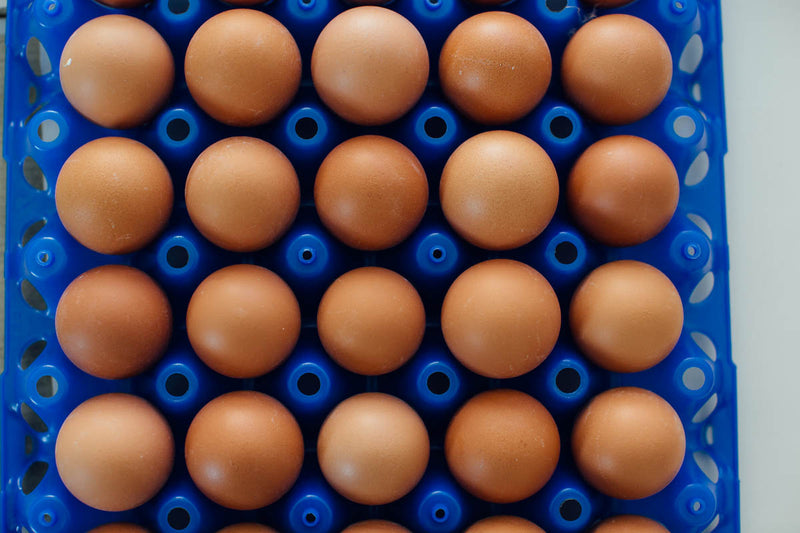
The Egg's Amazing Journey!
At the Farm
The journey begins in a nesting box, inside the barn, where one of our hens lays her egg. She will typically lay one egg per day, usually in the morning hours. From there the egg will slowly roll down the inclined, padded surface of the nesting box to the conveyor belt that runs the length of the barn. It will usually sit motionless on the belt until about 11AM when the farmer turns on the belt and gets ready to pack eggs in the packing room. The conveyor delivers the egg, along with several thousand others from that morning, to the packing station. A packing machine gently loads the eggs from the conveyor into plastic trays. The farmer, and if they are lucky a family member or two, run the packing machine, pull out any cracked eggs, and carefully stack the trays of eggs onto a pallet. Each pallet contains 900 dozen eggs. The pallet is then rolled into the adjacent cold storage room that is kept at 45 degrees.
On the Road
Once a week, one of our fleet of Nellie's "Rooster Cruiser" trucks will turn into the farm and roll up to the small loading dock next to the cold storage room. At that time, the week's worth of eggs, somewhere between ten to twenty thousand dozen, depending on the farm, will be loaded onto the truck. The truck will make a few more stops at other farms in the area until it is full and then proceed to one of our two processing plants in Pennsylvania or New Hampshire.
In the Plant
At the plant, the egg will now be rolled into our "nest run" cold storage area. When we are ready to run the eggs from that farm, the egg trays are loaded into our egg washer where they first go through an Organic citrus-based solution. Brushes do a gentle scrub before they get a sanitizing rinse.
At this point things get pretty technical as each individual egg is photographed and cataloged by the computer. The camera is looking for specs of dirt, cracks and other imperfections. It is also gauging the size of the egg so that down the line it will know to send them to the correct packing station for Large, Extra Large, Jumbo and so on. Each egg is also tapped lightly by a tuning fork at this stage to test for hairline cracks that the camera cannot see. Broken or otherwise problematic eggs are pulled from the line automatically. A little less than 1% of them are simply thrown out to become pig feed for other farms and other are sent to a "breakers" line where they are cracked into our liquid egg products. The intact eggs move up the line to the packaging station based on their size and are automatically placed into cartons, never being touched by human hands. From there they go into master cases and are put back onto a truck.
To the Store
From here, the trail can get a little complicated. Sometimes, our trucks will deliver right to a grocery chain's central warehouse and they will redistribute them to their individual stores. In other cases, we might deliver them to an independent distributor to haul for us. And in some cases, we might even deliver our eggs to a big factory farm where they are "cross docked" and loaded onto other trucks that do individual store delivery. That's because we don't operate a big enough fleet to drive to individual stores, nor would we have enough eggs of our own to deliver even if we did. So in those cases where a big caged egg company is also the sole egg distributor for a given location, we have to "ride along" with them. That's why you can see our trucks backed up to these mega farms. It's not because we're picking up eggs there, it's because we're delivering them there! Not an ideal situation, but for us, the only way to get our eggs where they need to go.
On Your Table
The final leg of the journey is from the store's back room out to the egg shelf, and then home to your kitchen table. The typical time from nest to table is about 25 days. That is well within what USDA recommends for fresh egg consumption and still leaves plenty of time for you to store in your refrigerator before eating. We print the "Best By" date right on our carton as to when we recommend you consume the eggs by. But don't worry, eggs are very resilient to spoiling and it's possible to eat them beyond that date and be fine. We don't recommend that of course, but typically you only lose a little bit of freshness. A good test if you're not sure of an egg's freshness is to drop it into a bowl of water. If it sinks, it's still fresh. If it floats, that means that the egg has had time to develop air pockets between the shell and the egg and it's time to toss it.
Once your eggs are safely home from the store and in the fridge, it's time to cook them up! If you're looking for recipe inspiration, here are some of our favorites.











